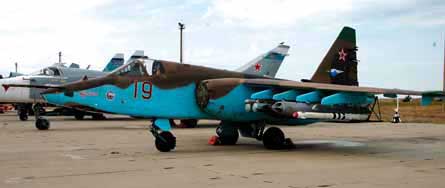While its continued military presence in Georgia has drawn widespread condemnation from much of the international community, Russia is already looking to learn the lessons from its air force performance during last month's five-day war.
Immediate, medium and long-term objectives are likely to be identified through its analysis of the conflict, which was sparked by Georgia's ill-fated move to stamp its authority on the breakaway region of South Ossetia.
ADDITIONAL FUNDING
Russian president Dmitry Medvedev says additional funding will be provided to acquire new equipment to eliminate any deficiencies identified, and with petro-dollars in abundance, the key question for the Kremlin's strategists is how to spend it.
In the near term, the air force's two main workhorses of the war, the Sukhoi Su-24M bomber and Su-25 ground-attack aircraft, are likely to receive more funds for fleet-wide upgrades. The recently certified Su-24M2 and Su-25SM standards bring improved night attack capability, new navigation equipment and an extended arsenal of precision-guided weapons.
 |
|---|
Fresh measures may also be needed to reduce the vulnerability of the Su-25, with three of Moscow's aircraft having been lost during the 8-12 August conflict. A Cold War counterpart to the US Air Force's Fairchild A-10, the Su-25 fought on both sides, and provided vital close air support for ground troops.
Georgia's Su-25 inventory also suffered during the war, but previous government consideration of reviving production in Tbilisi after a gap of more than 15 years appears impossible, as key components were sourced from across the former Soviet Union.
Moscow may itself consider reviving production at its Ulan-Ude plant, which still retains some parts for the naval Su-25UTG trainer and the enhanced Su-39. Russia's navy has previously requested more UTGs for use on its aircraft carrier the Admiral Kuznetsov, but building the Su-39 would require modern engines and avionics equipment.
The Russian air force has previously studied a lightweight combat aircraft such as a single-seat version of Yakovlev's Yak-130. But questions remain as to whether an armed version of an advanced jet trainer would replace a purpose-designed and well-armoured ground-attack aircraft, or merely supplement it.
Another casualty of the fighting was Russia's Tupolev Tu-22 supersonic, swing-wing bomber. This could be a top priority following the humiliating loss near Gori on 9 August of a Tu-22M3-R reconnaissance aircraft from the defence ministry's Valery Chkalov main flight-test centre. The aircraft's navigator was killed when it was shot down by a radar-guided surface-to-air missile, most likely a 9K37 Buk (SA-11), and its two pilots captured and shown to the media.
 |
|---|
© Vladimir Karnozov |
Moscow on 18 August exchanged 15 Georgian prisoners of war for five of its personnel, including the Tu-22 pilots. These were transferred to hospitals in Moscow and visited at length by prime minister Vladimir Putin, accompanied by defence minister Anatoly Serdyukov and air force commander Gen Aleksandr Zelin. As many things in Russia are still decided by former-president Putin, his action could produce an outcome.
Upgrades are already approved for the air force's Long Range Aviation fleets of 74 Tu-95MS and 16 Tu-160 bombers, but its 124 Tu-22M3s are earmarked for retirement. However, the Kremlin now has the money and the will to maintain its entire strategic bomber force as a means of "active deterrence".
With relations with NATO and the USA also cooling, Russia could even renege on a promise to not enable its Tu-22Ms to be refuelled in-flight: a pact agreed by then-presidents Leonid Brezhnev and Jimmy Carter.
A broad modernisation of the Tu-22M3, with its focus on new navigation and electronic warfare equipment, extended range and increased service life, could help Moscow boost its strategic aviation force in a cost-effective way.
In the meantime, the Kremlin must also consider whether to produce more Tu-160s - a type deemed expensive and unnecessarily large and complicated - or instead invest in a next-generation bomber. Kazan could only assemble one or two more aircraft before exhausting its stock of parts, which are now uneconomic to produce, but could also assemble a handful of Tu-22M3s from existing stocks.
Russia could not have won the war without the massive airlift operation that moved 14,000 of its paratroopers to Sukhumi and Vladikavkaz, and the campaign placed additional stress on the air force's Antonov An-124s and Ilyushin Il-76s, already in need of modernisation.
With a resumption of An-124 production not appealing to Moscow, it may instead choose to invest in an Il-476 development of the Il-76, and in refurbishing additional Il-76MDs with Perm Motors PS90A turbofans.
Russia's vast fleet of Mil Mi-8 transport and Mi-24 assault helicopters also made a substantial contribution, and their involvement again highlighted its pressing need to modernise the types.
 |
|---|
© Sukhoi |
The air force earlier this year requested the production of new Su-34 bombers, Su-35 multirole fighters, Mi-28N attack and Kazan Ansat training helicopters, but a fresh state willingness to boost defence spending could also benefit RSK MiG. Battling a debt burden of almost $2 billion, it has already proposed selling rejected Algerian MiG-29SMT/UBT fighters to Moscow.
Source: Flight International
















